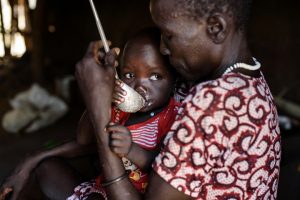
More people around the world are escaping extreme poverty than ever before. In just 10 years, 167 million fewer people are undernourished. But we cannot let another day go by without acknowledging that millions more children, men and women are currently at risk of starvation, and this progress is in danger of being reversed. Knowledge is power, as the old adage goes, and we are convinced that if more Americans know about this crisis we can save more lives.
This February, the world’s first famine in six years was declared in parts of South Sudan. Though it was recently downgraded, conditions in South Sudan have actually continued to deteriorate, and we are still on the brink of the worst humanitarian catastrophe of our time. The United Nations has warned that millions of families could face starvation in this lean period between growing seasons – primarily in Yemen, Nigeria, Somalia and South Sudan – and that 1.4 million children are severely malnourished and at imminent risk of death.
In South Sudan, families wade through miles of swamp to reach food, and people in Nigeria eat sand to ward off starvation. In Yemen, we see children with bloated stomachs from water retention and brittle, sparse and yellowish hair from lack of keratin. Some Somali farmers report 100 percent of their livestock are dying. Why are parents in these countries forced to decide between medical attention for one sick child and food for another? Why are we still asking these questions today, when we should have the power and resources to end this suffering?
There is no one simple answer, and we know that extreme weather patterns exacerbate dire conditions in these countries. It is no coincidence that the four countries teetering on the edge of famine – Yemen, South Sudan, Somalia and Nigeria – are all embroiled in violent conflict, whether it is prolonged civil war or violent extremist organizations exacerbating other vulnerabilities such as drought or weak governance. A decade ago natural disaster was the driver of 80 percent of the world’s humanitarian need. Today, that has been completely flipped on its head: conflict, a human-made disaster, has now taken its place.
Click here for the full article.
Originally published on the Huffington Post website.





